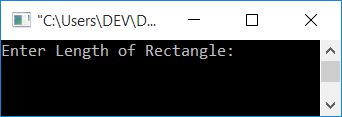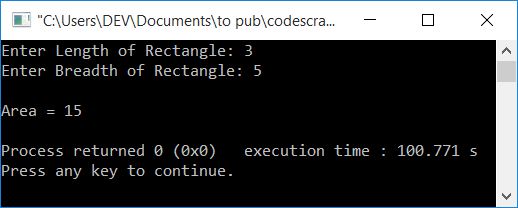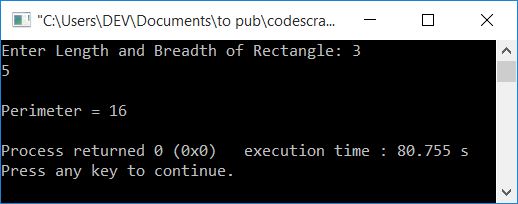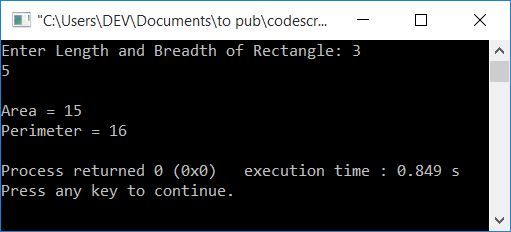- C++ Programming Examples
- C++ Programming Examples
- C++: Hello World
- C++: Get Input
- C++: Print Integer
- C++: Add two numbers
- C++: Add, Sub, Multiply, Div
- C++: Add Digits
- C++: Find Average and Percentage
- C++: Find Arithmetic Mean
- C++: Sum of n Natural Numbers
- C++: Sum of n Numbers
- C++: Square's Area and Perimeter
- C++: Rectangle's Area and Perimeter
- C++: Triangle's Area and Perimeter
- C++: Area and Circumference
- C++: Find Simple Interest
- C++: Fahrenheit to Celsius
- C++: Celsius to Fahrenheit
- C++: Print Prime Numbers
- C++: Reverse a Number
- C++: Swap Two Numbers
- C++: Print Multiplication Table
- C++: Find Factorial of a Number
- C++: Find Factors of a Number
- C++: Find HCF and LCM
- C++: Create a Calculator
- C++: Count Digits in a Number
- C++: First and Last Digit Sum
- C++: Product of Number Digits
- C++: Sum of Squares of Digits
- C++: Interchange Digits of Number
- C++ if-else Programs
- C++: Check Even or Odd
- C++: Check Prime or Not
- C++: Check Alphabet or Not
- C++: Check Vowel or Not
- C++: Check Leap Year or Not
- C++: Check Reverse equals Original
- C++: Check Perfect Number
- C++: Check Palindrome or Not
- C++: Check Armstrong or Not
- C++: Divisibility Test
- C++: Find Labor Wage
- C++: Find Discounted Price
- C++: Find Shipping Charge
- C++: Find Telephone Bills
- C++: Calculate Student Grade
- C++: Largest of Two Numbers
- C++: Largest of Three Numbers
- C++ Number Conversion
- C++: Decimal to Binary
- C++: Decimal to Octal
- C++: Decimal to Hexadecimal
- C++: Binary to Decimal
- C++: Binary to Octal
- C++: Binary to Hexadecimal
- C++: Octal to Decimal
- C++: Octal to Binary
- C++: Octal to Hexadecimal
- C++: Hexadecimal to Decimal
- C++: Hexadecimal to Binary
- C++: Hexadecimal to Octal
- C++ Pattern Programs
- C++: Pattern Programs
- C++: Print Diamond Pattern
- C++: Print Floyd's Triangle
- C++: Print Pascal's Triangle
- C++ Array Programs
- C++: 1D Array Program
- C++: Linear Search
- C++: Binary Search
- C++: Largest Element in an Array
- C++: Smallest Element in an Array
- C++: Find Second Largest Element
- C++: Find Second Smallest Element
- C++: Sum of All Elements
- C++: Multiply All Elements
- C++: Element in Even Position
- C++: Element in Odd Position
- C++: Print Even Numbers in Array
- C++: Print Odd Numbers in Array
- C++: Count Even or Odd Numbers
- C++: Sum of Even or Odd Numbers
- C++: Count Positive, Negative, Zero
- C++: Reverse an Array
- C++: Insert an Element
- C++: Delete an Element
- C++: Merge two Arrays
- C++: Bubble Sort
- C++: Selection Sort
- C++: Insertion Sort
- C++: Common Elements
- C++: 2D Array Programs
- C++: Add Two Matrices
- C++: Subtract Two Matrices
- C++: Transpose Matrix
- C++: Multiply Two Matrices
- C++: 3D Array Programs
- C++ String Programs
- C++: Print String
- C++: Find String Length
- C++: Compare Two Strings
- C++: Copy String
- C++: String Concatenation
- C++: Reverse a String
- C++: Delete Vowels from a String
- C++: Delete a Word from a String
- C++: Count Characters in a String
- C++: Count Words in a String
- C++: Frequency of Words
- C++: Remove Spaces from Strings
- C++: Sort a String
- C++: Uppercase to Lowercase
- C++: Lowercase to Uppercase
- C++: Swap Two Strings
- C++: Check the Anagram or Not
- C++: Capitalize All Words in a String
- C++: Get Numbers from a String
- C++ File Programs
- C++: Read a File
- C++: Write Content to a File
- C++: Append Data to a File
- C++: Read and Display File
- C++: Copy a File
- C++: Merge Two Files
- Count Characters in a File
- C++: Capitalize Every Word
- C++: List Files in Directory
- C++: Delete a File
- C++: Encrypt and Decrypt a File
- C++ Misc Programs
- C++: Print ASCII Value
- C++: Add Binary Numbers
- C++: Generate Random Numbers
- C++: Print a Smiling Face
- C++: Days into Years and Months
- C++: Add Two Numbers using Pointer
- C++: Print Fibonacci Series
- C++: Generate Armstrong Numbers
- C++: Find nCr and nPr
- C++: Get IP Address
- C++: Print Date and Time
- C++: Shutdown and Restart Computer
- C++ Programming Tutorial
- C++ Tutorial
C++ Program to Find the Area and Perimeter of a Rectangle
In this article, you will learn and get code for printing the area and perimeter of a rectangle based on length and breadth entered by the user at run-time in C++ programming. Here is the list of approaches used to find the area and perimeter of a rectangle:
- Find the area of a rectangle without using functions
- Using the function to calculate the area of a rectangle
- Without using function, calculate the perimeter of a rectangle
- Perimeter of a rectangle using function
- Using class and object, calculate the area and perimeter of a rectangle
Area of a Rectangle Formula
The formula to calculate the area of a rectangle is given below::
area = len*bre
Here, len indicates length and bre indicates breadth of the rectangle.
Perimeter of the Rectangle Formula
To calculate the perimeter of a rectangle, use the following formula:
perimeter = 2*(len+bre)
Here also, len and bre indicate the length and breadth of the rectangle, respectively. Now let's move on to the program.
In C++, find the area of a rectangle
The question is, "Write a program in C++ to find and print the area of a rectangle." The program given below is the answer to this question:
#include<iostream> using namespace std; int main() { float len, bre, area; cout<<"Enter Length of Rectangle: "; cin>>len; cout<<"Enter Breadth of Rectangle: "; cin>>bre; area = len*bre; cout<<"\nArea = "<<area; cout<<endl; return 0; }
This program was built and runs under the Code::Blocks IDE. Here is its sample run:

Now enter the length and breadth of the rectangle and press the ENTER key to see the area based on the given length and breadth of the rectangle, as shown in the output given below:

When the user enters length, it gets initialized to len, and when the user enters breadth, it gets initialized to bre. Using the formula, len*bre gets initialized to the area variable, which holds the area of the rectangle. Therefore, just print its value as output.
Using the function to calculate the area of a rectangle
Let's create the same-purpose program using a user-defined function, areaOfRectangle(). This function takes two arguments and returns a single value. The two arguments are length and breadth, whereas its return value will be the area of the rectangle.
#include<iostream> using namespace std; float areaOfRectangle(float, float); int main() { float len, bre, area; cout<<"Enter Length of Rectangle: "; cin>>len; cout<<"Enter Breadth of Rectangle: "; cin>>bre; area = areaOfRectangle(len, bre); cout<<"\nArea = "<<area; cout<<endl; return 0; } float areaOfRectangle(float len, float bre) { return (len*bre); }
In C++, determine the perimeter of a rectangle
Now let's find and print the perimeter of a rectangle without using a function.
#include<iostream> using namespace std; int main() { float len, bre, per; cout<<"Enter Length and Breadth of Rectangle: "; cin>>len>>bre; per = 2*(len+bre); cout<<"\nPerimeter = "<<per; cout<<endl; return 0; }
Here is a sample run of the above program:

Now supply the values of length and breadth of a rectangle to find its perimeter and print it as shown in the output given below.

Perimeter of a rectangle using function
Here is another program that also finds and prints the perimeter of a rectangle using a user-defined function.
#include<iostream> using namespace std; float perOfRectangle(float, float); int main() { float len, bre; cout<<"Enter Length and Breadth of Rectangle: "; cin>>len>>bre; cout<<"\nPerimeter = "<<perOfRectangle(len, bre); cout<<endl; return 0; } float perOfRectangle(float len, float bre) { return (2*(len+bre)); }
Using Class, calculate the area and perimeter of a rectangle
Now let's combine both and create a single program using classes to find the area and perimeter of a rectangle.
#include<iostream> using namespace std; class CodesCracker { private: float len, bre; public: void getData(); float areaOfRect(); float periOfRect(); }; void CodesCracker::getData() { cout<<"Enter Length and Breadth of Rectangle: "; cin>>len>>bre; } float CodesCracker::areaOfRect() { return (len*bre); } float CodesCracker::periOfRect() { return (2*(len+bre)); } int main() { CodesCracker c; float area, per; c.getData(); area = c.areaOfRect(); per = c.periOfRect(); cout<<"\nArea = "<<area; cout<<"\nPerimeter = "<<per; cout<<endl; return 0; }
Here is its sample run with user input of 5 as length and 3 as breadth:

« Previous Program Next Program »